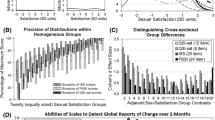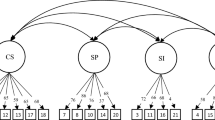Abstract
This is a review and chronological perspective on the development of self-report measures designed to describe an individual's sexual functioning. It includes scales that provide data on both heterosexual and homosexual behavior. Attitude scales are also included, but only those that reflect an individual's attitudes toward his own or his partner's behavior. Two classes of self-report measures are evaluated: (1) unidimensional scales that are relatively short and restricted in the information they supply; and (2) multidimensional inventories or questionnaires that elicit a wider variety of information. Available psychometric data are provided, and the measures are critically examined from both a research and a clinical point of view. It was concluded that unidimensional scales are probably more useful for research settings, while multidimensional inventories appear to have greater potential in clinical settings. All the test instruments reviewed would benefit from refinements, and recommendations are made that additional validity studies be conducted and more normative data be provided.
Similar content being viewed by others
References
Allen, R. M., and Haupt, T. D. (1966). The Sex Inventory: Test-retest reliabilities of scale scores and items.J. Clin. Psychol. 22: 375–378.
Barker, W. J., and Perlman, D. (1975). Volunteer bias and personality traits in sexual standards research.Arch. Sex Behav. 4: 161–171.
Bentler, P. M. (1968a). Heterosexual behavior assessment. I. Males.Behav. Res. Ther. 6: 21–25.
Bentler, P. M. (1968b). Heterosexual behavior assessment. II. Females.Behav. Res. Ther. 6: 27–30.
Brady, J. P., and Levitt, E. E. (1965). The scalability of sexual experiences.Psychol. Rec. 15: 275–279.
Cowden, J. E., and Morse, E. L. (1970). The relationship of defensiveness to responses on the Sex Inventory.J. Clin. Psychol. 26: 505–509.
Cowden, J. E., and Pacht, A. R. (1969). The sex inventory as a classification instrument for sex offenders.J. Clin. Psychol. 25: 53–57.
Derogatis, L. R. (1975).Derogatis Sexual Functioning Inventory. Clinical Psychometrics Research, Baltimore.
Derogatis, L. R. (1978).Derogatis Sexual Functioning Inventory (rev. ed.). Clinical Psychometrics Research, Baltimore.
Derogatis, L. R. (1980). Psychological assessment of psychosexual functioning.Psychiat. Clin. N. Amer. 3: 113–131.
Derogatis, L. R., and Melisaratos, N. (1979). The DSFI: A multidimensional measure of sexual functioning.J. Sex. Marital Ther. 5: 244–281.
Derogatis, L. R., and Meyer, J. K. (1979). A psychological profile of sexual dysfunctions.Arch. Sex. Behav. 8: 201–223.
Derogatis, L. R., Melisaratos, N., and Clark, M. M. (1976a). Gender and sexual experience as determinants in sexual behavior hierarchy.J. Sex. Marital Ther. 2: 85–105.
Derogatis, L. R., Meyer, J. K., and Dupkin, C. N. (1976b). Discrimination of organic versus psychogenic impotence with the DSFI.J. Sex. Marital Ther. 2: 229–240.
Derogatis, L. R., Meyer, J. K., and Gallant, B. W. (1977). Distinctions between male and female invested partners in sexual disorders.Amer. J. Psychiat. 134: 385–390.
Derogatis, L. R., Meyer, J. K., and Vasquez, N. (1973). A psychological profile of the transsexual. I. The male.J. Nerv. Ment. Dis. 166: 234–254.
Derogatis, L. P., Meyer, J. K., and Boland, P. (1981). A psychological profile of the transsexual. II. The female.J. Nerv. Ment. Dis. 169: 157–168.
Eysenck, H. J. (1972). Personality and sexual behavior.J. Psychosom. Res. 16: 141–152.
Farley, F. H., Nelson, J. G., Knight, W. G., and Garcia-Colberg, E. (1977). Sex, politics, and personality: A multidimensional study of college students.Arch. Sex. Behav. 6: 105–119.
Feldman, M. P., MacCulloch, M. J., Mellor, V., and Pinschof, J. M. (1966). The application of anticipatory avoidance learning to the treatment of homosexuality. III. The sexual orientation method.Behav. Res. Ther. 4: 289–299.
Fiske, D. W. (1971).Measuring the Concepts of Personality. Aldine, Chicago.
Galbraith, G. G. (1970). The Mosher Sex-Guilt Scale and the Thorne Sex Inventory: Intercorrelations.J. Clin. Psychol. 25: 292–294.
Galbraith, G. G., Kaplan, B., Higgins, J. D., and Tuton, K. (1968). Subscale intercorrelations of the Sex Inventory: Males and females.J. Clin. Psychol. 24: 451–453.
Guttman, L. (1950). The basis for scalogram analysis. In Stouffer, S. A., Guttman, L., Suchman, E. A., Lazarsfeld, P. F., Star, S. A., and Clausen J. A. (eds.),Measurement and Prediction (vol. 4). Princeton University Press, Princeton, New Jersey.
Harbison, J. J. M., Graham, P. J., Quinn, J. T., MacAllister, H., and Woodward, R. (1974). A questionnaire measure of sexual interest.Arch. Sex. Behav. 3: 357–366.
Haupt, T. D., and Allen, R. M. (1966). A multivariate analysis of variance of scale scores on The Sex Inventory, male form.J. Clin. Psychol. 22: 387–395.
Hoon, E. F., Hoon, P. W., and Wincze (1976). An inventory for the measurement of female sexual arousability: The SAI.Arch. Sex. Behav. 5: 291–300.
Joe, V. C., and Brown, C. (1975). A test of the Zuckerman heterosexual scales.J. Pers. Assess. 39: 271–272.
Kinsey, A. C., Pomeroy, W. B., and Martin, C. E. (1948).Sexual Behavior in the Human Male. Saunders, Philadelphia.
Kinsey, A. C., Pomeroy, W. B., Martin, C. E., and Gebhard, P. H. (1953).Sexual Behavior in the Human Female. Saunders, Philadelphia.
LoPiccolo, J., and Steger, J. (1974). The Sexual Interaction Inventory: A new instrument for assessment of sexual dysfunction.Arch. Sex. Behav. 3: 585–595.
Marks, I. M., and Gelder, M. G. (1967). Transvestism and fetishism. Clinical and psychological changes during faradic aversion treatment.Brit. J. Psychiat. 113: 711–729.
Marks, I. M., and Sartorius, N. H. (1968). A contribution to the measurement of sexual attitude.J. Nerv. Ment. Dis. 145: 441–451.
Marks, I. M., Gelder, M., and Bancroft, J. (1970). Sexual deviants two years after electric aversion.Brit. J. Psychiat. 117: 173–195.
McCoy, N. N., and D'Agostino, P. A. (1977). Factor analysis of the Sexual Interaction Inventory.Arch. Sex. Behav. 6: 25–35.
Norman, W. T. (1967). On estimating psychological relationships: Social desirability and self-report.Psychol. Bull. 67: 273–293.
Paitich, D., Langevin, R., Freeman, R., Mann, K., and Handy, L. (1977). The Clarke SHO: A clinical sex history questionnaire for males.Arch. Sex. Behav. 6: 421–436.
Podell, L., and Perkins, J. C. (1957). A Guttman scale for sexual experience—a methodoligical note.J. Abnorm. Soc. Psychol. 54: 420–422.
Rorer, L. G. (1965). The great response-style myth.Psychol. Bull. 63: 129–156.
Sallee, D. T., and Casciani, J. M (1976). Relationship between sex drive and sexual frustration and purpose in life.J. Clin. Psychol. 32: 273–275.
Schiavi, R. C., Derogatis, L. R., Kuriansky, J., O'Connor, D., and Sharpe, L. (1979). The assessment of sexual function and marital interaction.J. Sex. Marital Ther. 5: 169–224.
Thorne, F. C. (1966a). The Sex Inventory.J. Clin. Psychol. 22: 367–374.
Thorne, F. C. (1966b). A factorial study of sexuality in adult males.J. Clin. Psychol. 22: 378–386.
Thorne, F. C. (1966c). Scales for rating sexual experience.J. Clin. Psychol. 22: 404–407.
Thorne, F. C., and Haupt, T. D. (1966). The objective measurement of sex attitudes and behavior in adult males.J. Clin. Psychol. 22: 395–403.
Zuckerman, M. (1973). Scales for sex experience for males and females.J. Consult. Clin. Psychol. 41: 27–29.
Zuckerman, M., Tushup, R., and Finner, S. (1976). Sexual attitudes and experience: Attitude and personality correlates and changes produced by a course in sexuality.J. Consult. Clin. Psychol. 44: 7–19.
Author information
Authors and Affiliations
Rights and permissions
About this article
Cite this article
Conte, H.R. Development and use of self-report techniques for assessing sexual functioning: A review and critique. Arch Sex Behav 12, 555–576 (1983). https://doi.org/10.1007/BF01542217
Issue Date:
DOI: https://doi.org/10.1007/BF01542217




